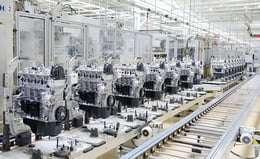Three Case Studies for Improving Production Planning
Nancy Sarpolis - March 09, 2022

Industry 4.0 technologies that improve efficiency, visibility and collaboration on the factory floor are being implemented in Fortune 500 companies as well as those with fewer than 100 employees. But the paths these companies take toward digitalization are just as varied as the organizations themselves. According to the Harvard Business Review, digital transformation is not a single thing, but a multi-faceted journey with differing goals depending on your industry and digital maturity.
Below are some case studies that show the paths three organizations are taking on their digitalization journey and the tools they’re using to improve production planning.
Leveraging existing systems
Many organizations, large and small, have legacy systems in place when they start their digital transformation journey. That was the case for a supplier of forklift trucks, warehouse equipment and automation technology. The supplier was looking for a way to optimize sequence planning and production control across its six European plants, taking into account production orders with varied characteristics, four-week lead times and restrictions regarding capacities, deadlines, and workload. The solution was an agile, automated planning and sequencing system connected to their existing SAP system. The sequencing solution can access the operations lists for each production order as well as all operations carried out to manufacture a product. For each operation, the system displays which production order is planned at each work center and the standard values used to determine the dates or the workload. Production planners can visualize a real-time view of the best possible sequence, taking into consideration all assembly and procurement restrictions.
The agile planning and sequencing system allows the supplier to manage complex processes in a standardized way, reliably meeting production targets. Planners appreciate the interactive customization options and flexibility of their new digital tools and report tangible savings of time and resources.
Adapting to shifts in demand
A manufacturer of light truck models that produces commercial vehicles for the European market needed to optimize production planning across several production lines. The manufacturer wanted to ensure that it could respond quickly to fluctuations in market demand while ensuring that orders could be scheduled without any loss of productivity or production bottlenecks.
An agile planning solution was the answer. It ensures that all production lines are optimally utilized and that dependent reference assembly lines—in upstream trades, for example—are perfectly coordinated. The intuitive solution creates transparency and clearly displays the status of all production lines and components. A monitoring solution tracks the availability of necessary components in real-time. Order changes can be made based on assured material availability. Orders that cannot be built are identified early and can be rescheduled with sufficient lead time. In this way, preventive measures can be taken and supply bottlenecks avoided. In addition, the manufacturer reports there are virtually no sudden additional costs due to last-minute rescheduling.
Using the cloud for flexibility
A sports car manufacturer with an order horizon of several months was looking for an automated software solution for daily planning. The previous application was outdated and not very user-friendly. There were sometimes long run times and the approval process was complex. They needed a solution that was generic enough to be used in seven different plants with different planning requirements. The manufacturer also wanted the solution to be available in the cloud so it could later be operated in the cloud itself.
A sequencing solution was the answer. It gave the manufacturer the ability to more easily accomplish short-term planning as well as horizons of up to one year. The cloud-based slotting solution was deployed across all plants quickly and smoothly. As a result, the manufacturer reports performance improvements such as reduced run times from several minutes to a few seconds per run, an increase in transparency and more stability in production.
The wealth of customer data, analytics, and growing transparency in the global supply chain is allowing business leaders greater leverage and control over their enterprises. Finding the right digital tools to improve efficiency and productivity is critical, no matter where your organization is on its Industry 4.0 journey.
If you want to learn more get your Guide to Transformation of Manufacturing Processes
In this Guide you will learn:
-
Emerging challenges in the modern automotive industry
-
How global OEMs can adapt to new realities
-
How decentralized digital systems power smarter planning processes
-
How flexis can support flexible supply chain transformation
LATEST POSTS
- Understand Why Production Planning Needs Specialized Solutions
- Understand Circular Economy in The Manufacturing Industry
- How Can Industry 4.0 IT Integration Be Achieved Smoothly?
- The Significance of Order Sequencing in Discrete Manufacturing
- How to improve your Supply Chain Management: The Power of Control Towers



